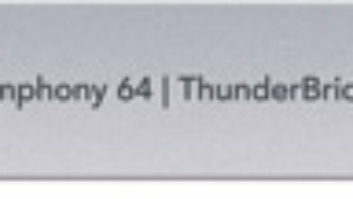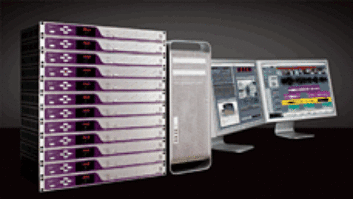
Apogee topped itself with the release of its latest product, the AD-16X and DA-16X converters. The new units replace the company’s similarly named AD-16 and DA-16, but share virtually nothing in common electronically with their predecessors. The new I/O twins owe their superb performance in part to the incorporation of Apogee’s jitter-nuking C777 clocking technology, which was first used in the company’s Big Ben master clock (reviewed in Mix, December 2003).
TOURING THE AD-16X
The 1U rackmountable AD-16X provides 16 channels of 24-bit A/D conversion at standard sampling rates from 44.1 to 192 kHz, and can lock to internal crystal or external word clock input.
Apogee AD-16X
All I/Os are on the unit’s rear panel. Sixteen balanced analog inputs are via two DB-25 connectors. Another DB-25 connector provides either 16 channels of single-wire or eight channels of double-wire AES/EBU output (selectable from the front panel). The supplied AD-16X user’s guide gives detailed pin-out diagrams for all DB-25 connectors, and Apogee also offers optional breakout cables with XLR fan ends ($179.95 per set) for use with these connectors. The AD8-IFC provides eight XLR female connectors for analog input (two sets are needed for 16 channels), and the AES16 I/P IFC provides 16 channels of AES output on XLR male connectors.
Four Toslink optical connectors on the AD-16X’s rear panel also output digital audio in one of the following formats (depending on the AD-16X’s currently selected sampling frequency): ADAT (16 channels at 44.1 or 48kHz rate), S/MUX 2 (16 channels at 88.2 or 96 kHz) or S/MUX 4 (eight channels at 176.4 or 192 kHz). Additionally, an option slot accommodates either an X-FireWire or X-HD card ($595 each) for direct interfacing with a computer equipped with FireWire or Pro Tools|HD connections, respectively. All digital output connections are always simultaneously hot, and each analog input gets routed to its corresponding numbered digital outputs.
Rounding out the AD-16X’s rear panel are word clock I/O (on BNCs), a word clock termination switch and a three-prong receptacle for the detachable AC cord. The AD-16X’s Word Clock (WC) Ratio function allows the unit to operate at 2x or 4x multiples to the WC input frequency at up to the maximum rate of 192 kHz. Alternatively, the WC Ratio function can output clock at 2x or 4x frequency multiples (again, up to 192 kHz) with respect to the internal sampling rate. Should there ever be a loss of source clock, Apogee’s SureLock technology ensures that the AD-16X continues to output stable clock. Electrically speaking, the AD-16X (and DA-16X) can operate at 100 to 240 VAC and at 50 to 60 Hz for plug-and-play operation anywhere in the world.
The AD-16X’s analog inputs are factory calibrated such that a +4dBu signal reads -16 dBFS. However, you can adjust the unit’s analog sensitivity (using digital front panel controls) to produce 0dBFS readings over an input range of +6 to +24 dBu, thus accommodating either +4dBu or -10dBV nominal systems. User calibration settings are non-volatile and can be adjusted either globally or independently for each channel, in either 1 or 0.01dB increments.
Apogee’s superb Soft Limit processing (an extremely transparent analog limiter with minimal overshoot) can be applied independently to any or all channels. The company’s acclaimed UV22HR processing can also be applied independently to any number of channel pairs (at 44.1- or 48kHz rate only) to reduce their signals’ bit depth from 24 to 16 bits while preserving much of the low-level detail that was in the original signals.
Metering for the AD-16X is rudimentary. Each channel sports one green LED that glows brighter as digital output level increases from -36 to 0 dBFS and a red LED for digital “overs.” You can clear the red LEDs manually or automatically by employing one of two peak-hold modes. One mode clears the meters after one second, while the other does so when signal level drops below -50 dBFS for at least five seconds and then recovers (as happens when starting a new take).
CRUISIN’ THE DA-16X
The 1U rackmountable DA-16X supports the same digital formats and sampling rates as the AD-16X, and all of its I/O are also on its rear panel. I/Os include two DB25 connectors for the 16 analog outputs, another DB25 providing AES/EBU input (16 channels of single-wire or eight channels of double-wire format), four Toslink connectors for ADAT- and S/MUX-formatted digital inputs and an option card slot to accommodate digital inputs via an X-FireWire or X-HD card. (The option cards are bi-directional and can therefore be used in multiple AD-16X and DA-16X units to achieve, for example, 32 inputs and outputs at once with Pro Tools.) Word clock I/O (on BNCs) and an AC receptable round out the DA-16X’s rear panel. Unfortunately, the unit’s word clock termination switch is located inside the chassis. Apogee remedied this; in later batches, the switch is located outside the chassis.

Apogee DA-16X
The DA-16X can lock to internal crystal, word clock input or digital input (i.e., clock embedded in a digital audio signal) and features the same WC Ratio function as the AD-16X.
The DA-16X ships calibrated to provide +4dBu analog output for a -16dBFS digital input, but can be calibrated globally or on a per-channel basis with the same incremental resolution and over the same range as the AD-16X. An internal oscillator with adjustable digital reference level is included to aid calibration. A single green LED for each channel indicates digital input level from -36 to 0 dBFS according to how bright it shines.
A/B COMPARISONS
With an A-weighted dynamic range of 120 dB, the AD-16X’s converters conveyed a strong sense of realism. In A/B tests, they provided significantly greater depth, focus and high-frequency detail than the Apogee Rosetta 800’s A/D converters. The Rosetta 96’s A/Ds, on the other hand, provided a hair more depth and fluidity in mids and highs than the AD-16X’s converters. The differences were extremely subtle, but sounded as if the mics were moved a couple inches closer to the source (without added proximity effect) from a couple feet away to reveal a tad more nuance.
The DA-16X’s converters boast an A-weighted dynamic range of 118 dB. They sounded a little more fluid, warmer, sweeter and 3-D than the D/As in the Benchmark DAC-1. Compared to the D/As in a Rosetta 800 (with the entire system slaved to Big Ben clock), the DA-16X’s converters offered slightly better transient response and more open low mids, but the Rosetta 800’s bottom end sounded slightly bigger and tighter.
While neither unit is inexpensive, the AD-16X and DA-16X represent a dramatic breakthrough in price-per-channel for high-performance converters. To my knowledge, there are no other high-end converters on the market that deliver such world-class performance at such a great price. I highly recommend them. Price: $3,495 (basic configuration).
Apogee, 310/915-1000, www.apogeedigital.com.



